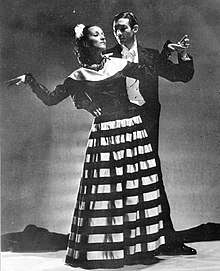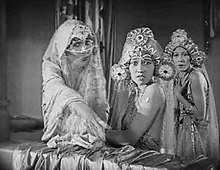Anita Thompson Dickinson Reynolds
Anita Thompson Dickinson Reynolds (1901–1980) was an African American model, dancer, and actress.[1] She was born in Chicago, Illinois, on March 28, 1901,[2] and died in St. Croix, United States Virgin Islands in 1980.
Anita Thompson Dickinson Reynolds | |
|---|---|
 Anita Thompson Dickinson Reynolds | |
| Born | Anita Thompson 1901 Chicago, Illinois |
| Died | 1980 (aged 78–79) Chicago, Illinois |
| Occupation | Model, dancer, actress |
| Years active | 1920s-1980 |
Life
Anita Thompson was born in 1901 into a politically engaged middle-class African-American family. She grew up in Los Angeles, California where her mother Beatrice Thompson was active in the NAACP. Her uncle was Noah Thompson whose wife was Eloise Bibb Thompson. She trained as a dancer and performed with Rudolph Valentino.Langston Hughes was a cousin; guests at the family home in Los Angeles included Booker T. Washington and W. E. B. Du Bois.

Career

Reynolds is considered one of the first Black stars of silent film. In early-1920s Hollywood, she studied dance with Ruth St. Denis, played an Arab servant girl in “The Thief of Bagdad” and starred in one of the earliest black-produced films, “By Right of Birth,” in 1921, about a black girl whose adoptive white parents conceal her racial origins.

Moving on from acting, Reynolds circulated the fashion scene, finding a career in modeling. In the 1930s, she modeled clothes for the famous French brand Chanel.
Personal life
She worked as a nurse in France between the wars and left after the Nazi occupation. Upon her return to the United States, she studied to be a psychologist. Reynolds was also a teacher and art instructor. Her memoirs “American Cocktail: A ‘Colored Girl’ in the World” were published by Harvard University Press in January 2014, based on notes in interviews by Howard Miller and edited by Cornell University professor George B. Hutchinson.
"Passing" in Hollywood
Due to Reynolds racially ambiguous appearance, she was able to navigate 1920s-1940s Hollywood with a lot more ease than her darker-skinned counterparts. However, like Fredi Washington—another white passing Black actress, Reynolds never actively denying her racial identity, but allowed lovers and others to see her variously as American Indian, East Indian, “high yaller,” “wild baby,” “part Cherokee,” “brown-skinned,” “yellow peril” or “sugar cane." She called herself an "American Cocktail".[3]
Reynolds traveled easily between the mostly white bohemia of Greenwich Village and the clubs and salons of Harlem, seemingly meeting everyone who was anyone. She was able to move on to Paris and then the expatriate colony in Morocco, along the way collecting lovers, several aborted writing projects and a torrent of acquaintances with droppable names, including James Joyce, Ernest Hemingway, Claude McKay, Paul Bowles, Gertrude Stein, E. E. Cummings, Picasso and Coco Chanel.[4]
"Most of my contemporaries, both black and white, have had chiefly tales of woe tell.[5] I feel a little guilty saying how much fun I have had being a colored girl in the twentieth century." [6]
References
- Schuessler, Jennifer (17 February 2014), "A Breezy Chameleon, Blurring Social Borders", The New York Times, pp. C1 (of the NY edition), retrieved 21 September 2014
- Reynolds, Anita Thompson Dickinson. American cocktail: a "colored girl" in the World. Cambridge, Mass.: Harvard Univ. Press, 2014. p. 61.
- Schuessler, Jennifer (17 February 2014), "A Breezy Chameleon, Blurring Social Borders", The New York Times, pp. C1 (of the NY edition)
- Schuessler, Jennifer (17 February 2014), "A Breezy Chameleon, Blurring Social Borders", The New York Times, pp. C1 (of the NY edition)
- Miller, Howard (2014), American cocktail: a "colored girl" in the World. Cambridge, Mass.: Harvard Univ. Press, 2014. p.6.
- Miller, Howard (2014), American cocktail: a "colored girl" in the World. Cambridge, Mass.: Harvard Univ. Press, 2014. p.7.
External links
- Anita Thompson Dickinson Reynolds on IMDb
- Anita Thompson in Harlem World Magazine